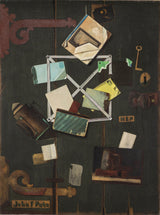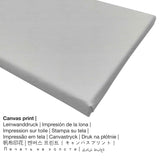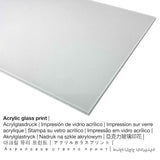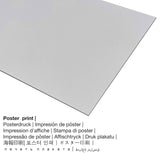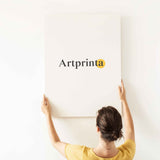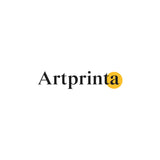John Frederick Peto, 1900 - HSP's Rack Picture - druk artystyczny
Podatek jest wliczony. Koszt wysyłki zostanie obliczony W kasie.
Materiały, z których mogą wybierać nasi klienci
W menu rozwijanym produktu możesz wybrać materiał i rozmiar zgodnie ze swoimi preferencjami. Możesz wybierać spośród następujących opcji personalizacji produktu:
- Obraz na szkle akrylowym (z powłoką z prawdziwego szkła na wierzchu): The acrylic glass print, often referenced as a an art print on plexiglass, will convert your selected original into brilliant décor. The artwork is made with the help of state-of-the-art UV printing machines. This creates impressive and vivid color hues. With an acrylic glass fine art print contrasts plus small artwork details will be more exposed with the help of the delicate gradation.
- Nadruk z dibondu aluminiowego: Aluminium Dibond prints are metal prints with an impressive effect of depth, which creates a fashionable impression throuch a non-reflective surface structure. The direct print on Aluminum Dibond is one of the most demanded entry-level products and is a sophisticated way to display art prints, since it puts the viewer’s attention on the artwork.
- Brezentowy: A printed canvas material mounted on a wood stretcher frame. Canvas Prints have the advantage of being relatively low in weight, which means that it is quite simple to hang up your Canvas print without the support of extra wall-mounts. Hence, canvas prints are suited for all types of walls.
- Plakat na płótnie materiał: Our poster print is a printed canvas with a slightly roughened texture on the surface, which reminds the actual version of the masterpiece. Please keep in mind, that depending on the size of the canvas poster print we add a white margin 2-6cm around the painting in order to facilitate the framing.
Zastrzeżenia prawne: We try the best we can to describe the art products as precisely as possible and to illustrate them visually on the respective product detail pages. Please keep in mind that the colors of the print products, as well as the imprint can vary slightly from the image on the screen. Depending on your settings of your screen and the nature of the surface, not all colors are printed one hundret percent realistically. Bearing in mind that our art reproductions are printed and processed manually, there may also be slight variations in the exact position and the size of the motif.
What does the original artwork description of the Los Angeles County Museum of Art say about the 20th century artwork made by John Frederick Peto? (© - Muzeum Sztuki Hrabstwa Los Angeles - Los Angeles County Museum of Art)
John Frederick Peto (1854-1907) was born and raised in Philadelphia. He espoused a highly realistic style of painting that reflected the period's rationalism and concern for materiality, an aesthetic in opposition to the freer and individualistic handling of paint of the contemporaneous impressionists. In the late 1870s, Peto entered the Pennsylvania Academy of the Fine Arts, where he became friends with William Harnett, recently returned to the academy after several years in New York City. It was about this time that Harnett began exhibiting his mature illusionistic still lifes. Although most still life painters aim to be convincingly realistic, Harnett went beyond mere imitation, often to the point of deception. These still lifes made Harnett’s fame and spawned a virtual movement of followers. Peto considered Harnett his "ideal of perfection in still life painting," and as Harnett, specialized in still lifes, both table-top compositions and trompe l’oeil ("deceives the eye"). Yet Peto was no mere imitator. Unlike many of his contemporaries, Peto did not consider the visual trickery and illusion so often associated with works of trompe l’oeil as the sole aim of his art. In Harnett’s paintings, objects were depicted so realistically that many people actually had to touch the canvas before they were convinced that the objects they were seeing were painted, not "real." Peto, however, was more concerned with the manner in which light could affect an object rather than with the precise rendering of that object, and his canvases have a softer, less hard-edged style. Read more (Curator Notes)
Twórcą malarstwa współczesnego jest m.in zły American painter John Frederick Peto in 1900. Ponadto dzieło to jest zawarte w Muzeum Sztuki Hrabstwa Los Angeles Digital Art Collection, które jest największym muzeum sztuki w zachodniej części Stanów Zjednoczonych, ze zbiorem ponad 142.000 6.000 obiektów, które ukazują XNUMX lat ekspresji artystycznej na całym świecie. Ten domena publiczna artpiece is included with courtesy of Los Angeles County Museum of Art (www.lacma.org).In addition to that, the work of art has the creditline: . In addition to that, the alignment of the digital reproduction is in portret format ze współczynnikiem boku 3: 4, co implikuje długość jest o 25% krótsza od szerokości. The painter John Frederick Peto was an artist from United States, whose artistic style can mainly be classified as Realism. The painter was born in 1854 in Philadelphia, Philadelphia county, Pennsylvania, United States and died at the age of 53 w roku 1907 w Nowym Jorku, stan Nowy Jork, Stany Zjednoczone.
Stół z dziełami sztuki
| Nazwa dzieła: | "HSP's Rack Picture" |
| Kategoryzacja dzieła sztuki: | malarstwo |
| Termin ogólny: | sztuka współczesna |
| Okres: | 20th wieku |
| Rok dzieła: | 1900 |
| Wiek dzieła: | 120 lat |
| Oryginalny nośnik grafiki: | olej na płótnie |
| Muzeum: | Los Angeles County Museum of Art |
| lokalizacja muzeum: | Los Angeles, Kalifornia, Stany Zjednoczone Ameryki |
| Strona internetowa muzeum: | www.lacma.org |
| Rodzaj licencji dzieła sztuki: | domena publiczna |
| Dzięki uprzejmości: | Muzeum Sztuki Hrabstwa Los Angeles (www.lacma.org) |
Specyfikacja produktu
| Rodzaj produktu: | kopia sztuki |
| Metoda rozmnażania: | reprodukcja cyfrowa |
| Proces produkcji: | druk cyfrowy |
| Pochodzenie produktu: | wyprodukowano w Niemczech |
| Rodzaj akcji: | produkcja na żądanie |
| Przeznaczenie produktu: | galeria druków artystycznych, sztuka ścienna |
| Wyrównanie: | wyrównanie portretu |
| Współczynnik obrazu: | (długość : szerokość) 3 : 4 |
| Interpretacja proporcji boków: | długość jest o 25% krótsza od szerokości |
| Dostępne warianty: | wydruk plakatu (papier płócienny), wydruk na płótnie, wydruk w metalu (dibond aluminium), wydruk na szkle akrylowym (z powłoką z prawdziwego szkła) |
| Warianty obrazu na płótnie (płótno na blejtramie): | 30x40cm - 12x16", 60x80cm - 24x31", 90x120cm - 35x47" |
| Obraz na szkle akrylowym (z powłoką z prawdziwego szkła): | 30x40cm - 12x16", 60x80cm - 24x31", 90x120cm - 35x47" |
| Wydruk plakatu (papier płócienny): | 30x40cm - 12x16", 60x80cm - 24x31", 90x120cm - 35x47" |
| Opcje rozmiaru wydruku z dibondu aluminiowego: | 30x40cm - 12x16", 60x80cm - 24x31", 90x120cm - 35x47" |
| Ramka: | bez ramki |
Przegląd artystów
| Nazwa: | Jan Fryderyk Peto |
| Alternatywne nazwy: | John F. peto, Peto John F., John Frederick Peto, Peto John Frederick, Peto |
| Płeć artysty: | zły |
| Narodowość artysty: | amerykański |
| Zawody artysty: | malarz |
| Ojczyzna: | United States |
| Klasyfikacja: | współczesny artysta |
| Style sztuki: | Realizm |
| Długość życia: | 53 roku |
| Rok urodzenia: | 1854 |
| Miejsce urodzenia: | Filadelfia, hrabstwo Philadelphia, Pensylwania, Stany Zjednoczone |
| Rok śmierci: | 1907 |
| Zmarł w (miejsce): | Nowy Jork, stan Nowy Jork, Stany Zjednoczone |
© Prawa autorskie, Artprinta (www.artprinta.com)

